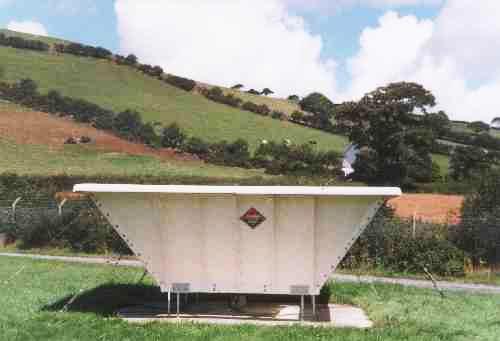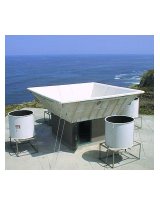atmos:535:projects:vaisala_lap-3000_lower_atmosphere_wind_profiler
Table of Contents
Lower Atmosphere Wind Profiler
Description
Theory
- Conventional Radar
- Conventional Radars detect reflections from airborne objects such as hydrometeors.
- Wind Profiler
- Wind profilers measure from the ground up. Again reflections are detected, but instead of hydrometeors, from turbulence and eddies.
- Wind profilers also operate below Radar frequencies.
- Remote sensing in done by acoustic and electromagnetic pulses.
- Doppler Beam Swing
- The components of velocity can be measured by one vertical beam and two off zenith beams.
- The beam pointing sequence is repeated every 1-5 minuets.
- Doppler Shift
- The Doppler shift depends on the relative motion of the source and the motion of the observer.
- Measurement of the wind speed is based on the Doppler shift. It is in the received signal where the radial velocities of the scattered motions are measured.
Operating Characteristics
| Operating Frequency | Specific freq chosen between 912 & 924 MHz or 1280 & 1300 MHz | |
| Occupied Bandwidth | Approximately 10 MHz @ 0.3 µs pulse duration (ITU 99%) | |
| Harmonic Emission | < -40 dB from fundamental emission | |
| EIRP | > 64.3 dBW | |
| Transmitter Type | 600 to 1000 Wpk solid-state module | |
| Pulse Repetition Frequency | 0.1 to 50 kHz, user selectable | |
| Pulse Width | 0.3 to 10 µs, typically 0.4, 0.7, 1.4 and 2.8 µs, user selectable | |
| Pulse Rise Duration (10-90%) | > 100 ns | |
| Pulse Fall Duration (90-10%) | > 100 ns | |
| Receiver Type | Heterodyne to 60 MHz IF frequency and digital IF | |
| Receiver Noise Figure | ≤ 1.2 dB (excludes antenna, T/R switch components) | |
| Receiver Linear Dynamic Range | > 84 dB | |
| Antenna Array Gain (dB) | 24 to 29 dBi (determined by frequency and antenna array size) | |
| Antenna Type | Electrically steerable, micropatch phased array formed by four or nine 0.82 – 0.87 m x 0.82 – 0.87 m antenna panels | |
| Array Beam Elevation Angle | Zenith and ± 15.5° or ± 23.6° from zenith in four orthogonal directions (determined by frequency and/or antenna array size) | |
| Array Beam Width | 6° to 10° at -3 dB power points (determined by frequency and antenna array size) |
Specifications
| Operating Frequency | Typically 915, 1290 MHz | |
| Minimum Height | 75-150 m | |
| Maximum Height | 2-5 km | |
| Range Resolution | 60, 100, 200, 400 m | |
| Wind Speed Accuracy | < 1 m/s | |
| Wind Direction Accuracy | < 10° | |
| Averaging Time | 3-60 minutes | |
| Radio Frequency Power Output | 600 W peak | |
| Antenna | Electrically steerable micro patch phased-array panels | |
| Aperture | 2.7 m² (4 panels) | |
| MTBF | 40,000 hours | |
| Power Requirements | 110 V / 60 Hz; 15 Amp or 220 V / 50 Hz; 10 Amp |
Field Projects
CAPS
- Cooperative Agency (Wind) Profilers
- Part of the ongoing wind profiler quality control program with NOAA/NECP
- Originally designed in the early 1990’s to run in the RUC network and read in and process data from the 36 original NOAA Profiler Network (NPN) sites.
- The NPN profiles reported on the hour and all winds over 43 levels, the first 36 separated by 250 meters and the last seven by 1000 meters.
- May 2002, NOAA/NECP started including data from wind profilers’ in CAP, such as the Vaisala LAP 3000 Lower Atmosphere Wind Profiler.
- These platforms report at levels different from the NPN sites, and the CAP sites can report as often as every fifteen minutes.
- As of 2003, the addition of the CAP sites increased the maximum number of sites a module code can process from 40 to 120.
The LAP 3000 can also be found for aviation support, mesoscale observations, and air quality monitoring.
Calibration
- Wind profiler data can be used to “calibrate” regional weather forecasts against national weather models.
- It helps determine how well national model forecasts are performing.
- The continuous flow of data allows forecasters to nudge models to better correct forecasts.
Deployment
Measurement Methods
- Remote Sensing
- Cloud droplets give a measurable signal.
- The signal is analyzed in the frequency domain to extract power, the Doppler shift, and the width of the signals peak.
- Using several electronic beam swings, the radial velocity of the three wind vector components can be computed.
- Radio Acoustic Sounding System (RASS)
- This system can provide a profile of virtual temperature.
- A strong continuous sine wave is synchronized to the wind profiler’s frequency.
- The wave travels as a comparison wave with the speed of sound, upwards in the atmosphere.
- The wind profiler then measures the speed of the propagation of the wave.
- Since waves are affected by air temperature, the virtual temperature can be computed from the received signal.
- Here we have a picture of a wind profiler with the addition RASS:
Deployment Methods
- It is recommended that a site for the boundary layer wind profiler should:
- Be accessible by vehicle
- Have a fence to protect the profiler
- Include a shelter for the software and other materials
- Also when setting up the site, you would want to avoid:
- Nearby moving objects (i.e. antennas and vehicles)
- Nearby objects visible more than 5° above the horizon (i.e. buildings and towers)
- Any active transmitters that are detectible by the profiler, and are within ±30 MHz above and below the profiler operating frequency
Applications
- Who uses wind profilers?
- Airports, air quality control, mesoscale forecasts, and tactical
- Wind profilers have proven to help in areas such as; land/sea breeze, severe weather, and Chinook winds.
- Boundary layer wind profiles can be helpful with predictions or forecasts too.
- The data from the profiler can help forecast maximum winds. This can be useful in situations involving fire weather or for military tactical purposes with chemical or toxic particles in the air.
- Also the National Weather Service has concluded that wind profile data has helped with severe storms.
- The data has helped improve Tornado Warnings by 3 min. or 38%.
- The data has also improved Flash Flood Warnings by 8 min. or 18%.
Data
- Since I have no experience working with a wind profiler, you may find data on the reference sites.
Reference
atmos/535/projects/vaisala_lap-3000_lower_atmosphere_wind_profiler.txt · Last modified: 2020/01/29 17:25 by 127.0.0.1

